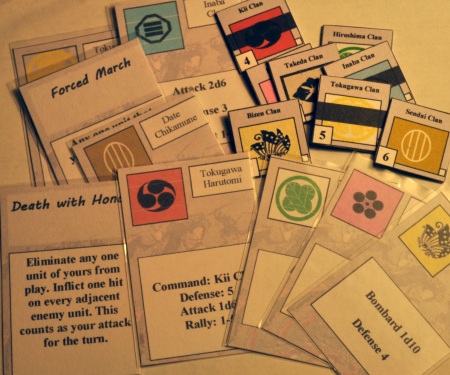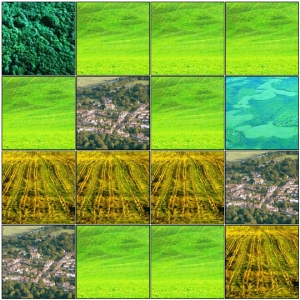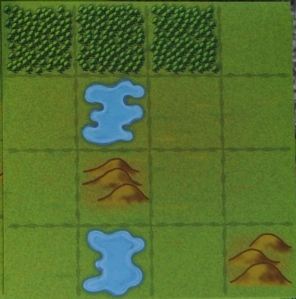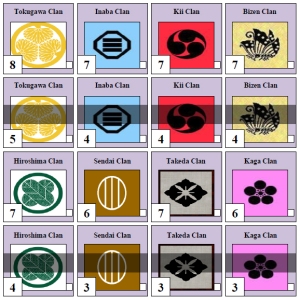Months ago, game designer Jeff Horger put out a call for playtesters for a Manouevre expansion. I immediately signed up. Not only is Manoeuvre one of my favorite games it would also give me a small glimpse into how a game gets made. Now that Distant Lands is on the P500 list I can finally talk about my experience.
Behind the Scenes
One of the reasons I signed up was to get a feel for what goes on with making games. I was sent a bunch of files that contained the rules and components for the Japanese army. The first thing I did was look through the rules and immediately had some questions. The new rules were pretty straightforward, but I wanted some clarifications. My other concern was with some of the components.
The new maps used completely different graphics and the units didn’t have the infantry and calvalry symbols on them. Instead they had a single box white box to represent infantry while two boxes represented cavalry. You’ll notice the Japanses don’t have any cavalry.
The response I got back on the new map graphics were that he had been using the different graphics for many years and that “[he was] so used to it [he] didn’t think twice about it.” I think this is one part of game design that is key: have several people that are not familiar with the game and components play it. They will point out mistakes and missing information very quickly.
I then printed and cut out the units and cards. I was thankful for my wife’s scrapbooking supplies which I used to adhere the units to some chipboard. Then I sleeved all the cards. Plain pieces of paper in card sleeves worked very well for the small size of these cards.

The components I made turned out pretty well. I should note that I changed the colors of the cards to use less ink for printing. I would assume the final components look much more like the original game.
Once all of that stuff was out of the way it was time to play.
Playing with a New Army
I tend to like expansions for games – they can breath new life into a game that hasn’t made it to the table in a while. Or in the case of the Distant Lands, they can force you to rethink your best strategies.
My wife and I sat down for our first game and both instantly liked the new rule: Advance to Contact. In your first turn of the game you are allowed to move up to 3 different units, in the 2nd turn you can move 2 units. After that it’s back to normal. This change gets both players engaged much more quickly.
The two Japanese map tiles contained more marsh and lake features. The new ‘cluttered’ maps helped to slow down cavalry. The Japanese units were mostly unaffected by this. I’m curious to see just how many new map tiles come with this expansion. Although the base game already has enough for 6 simultaneous games.
The deck of cards had some unique features as well. Here is the breakdown of the Japanese deck:
• 40 Unit Cards
• 3 Forced March Cards
• 3 Supply Cards
• 2 Committed Attack Cards
• 2 Redoubt Cards
• 2 Death with Honor Cards
• 8 Leaders
Two things will stand out right away: eight leaders and the Death with Honor cards. The Death with Honor cards allow you to eliminate a unit and then inflict hits on every adjacent unit. Normally in Manouevre you try to surround a unit to eliminate it more easily. Now if you play against the Japanese you have to be careful that surrounding a unit isn’t exactly what your opponent wants you to do. I my games I usually only used one of these cards. Inflicting up to 4 hits can be powerful but losing a unit isn’t a decision to take lightly.
The leader and unit cards also act slightly differently. The other armies work together to drive their opponents back. However, each Japanese unit is self contained. They each get 2 normal attack cards and their bombard. They also get a volley only card and an attack card with a pursuit roll. These five cards are supposed to represent the “samurai, ashigaru, cavalry, artillery and teppo” in each of the clans. The 6th card for each unit is actually a leader. The leaders for the Japanese can only command the 1 unit they lead. Only one of the leaders, the Shogun, can unite up to four of the clans. Although the units start at fairly high strengths of 6, 7 and 8, the Japanese are weaker than the other nations because of their deck. A handful cards containing a leader and a few different unit cards for most armies was quite useful – with Japan it was a disadvantage.
The strength with the Japanese was keeping the units somewhat isolated. It allowed you to march single units to your opponents side of the board. Each unit was self contained. I cycled through my deck quickly while building up attacks with each unit separately. If things started to get bad for a particular unit I would sacrifice them while doling out hits.

Conclusion
Overall I really had a good experience. It got me really excited about the new armies for Manoeuvre (Chinese combat rockets!). I am also proud to have been able to help out in the creation of what I’m sure will be a successful expansion. I was a bit overwhelmed at just what has to go into making a game – and this was just an expansion! The amount of time and thought that has to go into creating a set of rules and components is massive. And then the refinement after playtesting… But it certainly gave me a jolt to get working on my own game ideas.


